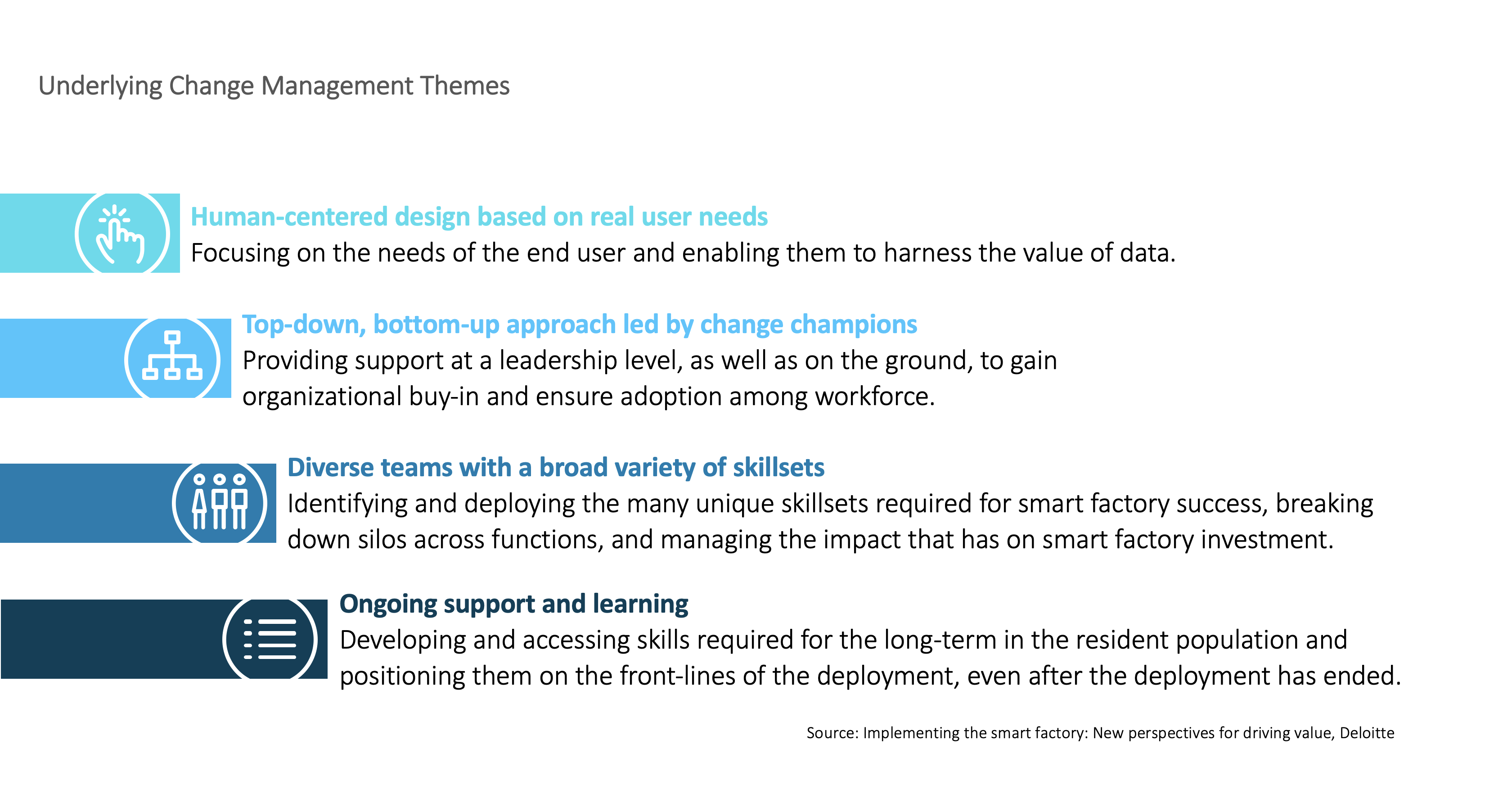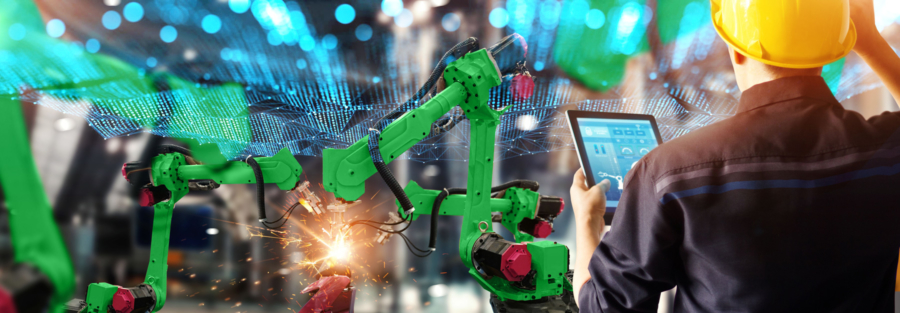New Perspectives for Driving Value in Smart Factory Implementation
Editor’s Note: In a recently published report, “Implementing the Smart Factory,” Deloitte thought leaders Stephen Laaper, Ben Dollar, Mark Cotteleer and Brenna Sniderman offer insights on how manufacturing leaders with hands-on experience are implementing and realizing value (cost, throughput, quality, safety and revenue growth) from smart factory transformations. The following is a summary of the report and its key findings. Visit Deloitte Insights to read the full report.
A smart factory is a flexible system which can self-optimize performance across a broader network, self-adapt to and learn from new conditions in real or near-real time, and autonomously run entire production processes. Smart factory technologies include industrial Internet of things; cloud and edge computing; robotic process automation; artificial intelligence (AI) and machine learning; vision systems and augmented and virtual reality systems.
In the United States alone, 86 percent of manufacturers believe that smart factories will be the main driver of competition by 2025 and 83 percent believe that smart factories will transform the way products are made. Yet only five percent of U.S. manufacturers surveyed in 2019 reported full conversion of at least one factory to “smart” status, and nearly two out of three (65 percent) manufacturers surveyed report no progress on initiatives to adopt smart factory technologies.
Today’s leaders have a broad range of choices and opportunities with respect to smart factory transformations, both in terms of which technologies to use, and how to deploy them. Considering lessons from those who have implemented a smart factory can provide manufacturers with direction forward and help pave the way to greater value realization. As in any transformation effort, culture and change management are key considerations [see Underlying Change Management Themes], but there are other factors that are more unique to the smart factory and its technologies. Below is an outline of the “smart factory-specific” lessons learned across the different deployments of our study participants, as well as how leaders can translate these lessons into value for their factories and their broader organizations.

1) Smart Factory Lessons Learned
- Criticality of Connectivity
Smart factory and its resulting value generally hinge on the ability to connect assets, processes, people, and devices. The issue of connectivity arose in nearly every smart factory deployment that Deloitte studied; in many facilities, Wi-Fi and cellular connectivity are often irregular in the labyrinth of steel and concrete. Connectivity was also identified as a top challenge for smart factory adopters in broader research: Thirty-three percent of smart factory leaders in the recent Deloitte-MAPI survey identified lack of necessary IT infrastructure as a significant impediment to smart factory initiatives. If an application or process can’t connect to the network to share and access information, it will fail no matter how well thought out it is. - The Need for a Flexible Approach to Assets
The variety of machinery, sensors, and other devices that exist on the shop floor must also be considered. Even within the same plant network, each facility is likely unique in terms of layout, equipment, and product. Smart factory practitioners identified multiple dimensions to this challenge, including:- Diversity in machine age: Smart factory deployments span some of the newest, most advanced manufacturing technologies in the world—as well as some of the oldest. Integrating across these age groups can be difficult, but it can allow leaders to access data about processes and functions that were previously impossible to get
- Diversity in purpose: In some cases, new real-world applications of devices provide teams with the chance to innovate, discover new ways to capture data, and find new opportunities for value.
- Diversity in data structure and format: In a smart factory, data comes from many sensors and devices and takes many formats. Cleansing and mapping efforts are often crucial to ensuring that data from one system or device can be combined and leveraged with data from another.
- Diversity in access methods: Adding sensors to all equipment is not always practical; issues with access, quality, security, or machine uptime may intervene. Teams may need to leverage technology to develop alternative means for measurement and data collection. For example, one interviewee explained how process control on older, analog machines was accomplished via digital cameras, AI, and vision systems to “read” gauges and capture data.
- Bridging the Divide Between IT and OT
Achieving balance among competing priorities of IT and operational technology teams can be challenging. IT organizations are focused on securing technology assets and maintaining system integrity, while OT are suddenly pushing to jump the firewall and enable access to these assets to outside entities. Be prepared for conflicts over data access and rights, IT development rights, and shifts in technology approach. Respecting the different professional cultures can help your teams find the sweet spot between connectivity and security.
2) Turning Lessons into Outcomes
- Illuminating the Hidden Factory
The infusion of connected assets and new flows of data enables organizations to see things that were always there, but previously impossible to observe or quantify. In addition, rapid increases in processing power have led to new analytics capabilities and the ability to generate ever-deeper insights, virtually impossible to produce even several years ago. For example, using predictive capabilities driven by advanced shop-floor analytics a manufacturer more than doubled production on existing capital equipment. With the right architecture in place, data can be shared across the connected ecosystem to inform fulfillment, product development, planning, supply, and customer service. - Leverage Current Systems for New Value
Interview subjects acknowledge the complexity and difficulty of connecting the range of systems and assets and stressed the need to be flexible in their approach to diverse devices, data, and systems. By integrating their current systems digitally and leveraging the data, companies can optimize operations, drive greater productivity, and leverage talent. For example, the marriage of lean manufacturing with smart factory principles extends existing lean capabilities providing more accurate, precise, and timely information about operations and resulting in a better ability to monitor production and report issues, among other capabilities. The smart factory can also enable smarter allocation of workforce. Data can indicate where maintenance crew, machine operators, and others need to be to optimize performance, and power persona-based tools that focus efforts on insights relevant to specific roles. Further, workers can team with digital and physical technologies to augment their capabilities, while the technology itself may also create wholly new roles within the smart factory. - Harness AI and Other Advanced Tools to Get to the Next Level
Advanced analytics, powered by AI, enable smart factory operators to comprehend information from their newly illuminated processes, and handle data loads as well as critical, previously unknown correlations in the data that a human, at scale, cannot. Leaders reported double-digit percentage improvements in production processes, machine utilization, and throughput from the deployment of AI-driven capabilities, including:- Predictive maintenance
- Dynamic routing of inputs and other materials throughout the facility
- Analyzing, sensing, and proactively responding to circumstances across the smart factor in a control tower
- Monitoring and optimizing performance of products or processes through the deployment of digital twins and digital threads
- Scaling Throughout Ecosystems and Digital Supply Networks
The influx of data and information can drive improved operations not just in one facility, but throughout the network and even the broader ecosystem. After piloting connected factory technologies in discrete locations, organizations recognize exponential value by scaling solutions beyond their four walls. For example, a consumer products manufacturer reported double-digit returns on an investment in advanced analytics and AI to optimize purchasing of production inputs across its manufacturing network.
Deloitte’s research clearly demonstrates that manufacturers broadly agree that the future of manufacturing is “smart,” and the empirical results we have seen as a part of this study clearly link to significant value delivery. Though there may be no single approach to successful smart factory deployment, we hope the insights from our research may help companies get themselves started on the path to realizing the vision and value of a smart factory future.
Comments or questions, click here to contact Implementing the Smart Factory” authors.
Related Resources:
Network: Manufacturers Alliance for Productivity and Innovation (MAPI)
Portal: Deloitte Smart Factory Services
Immersive Experience: The Smart Factory @ Wichita
Article: Smart Factory: Value First

